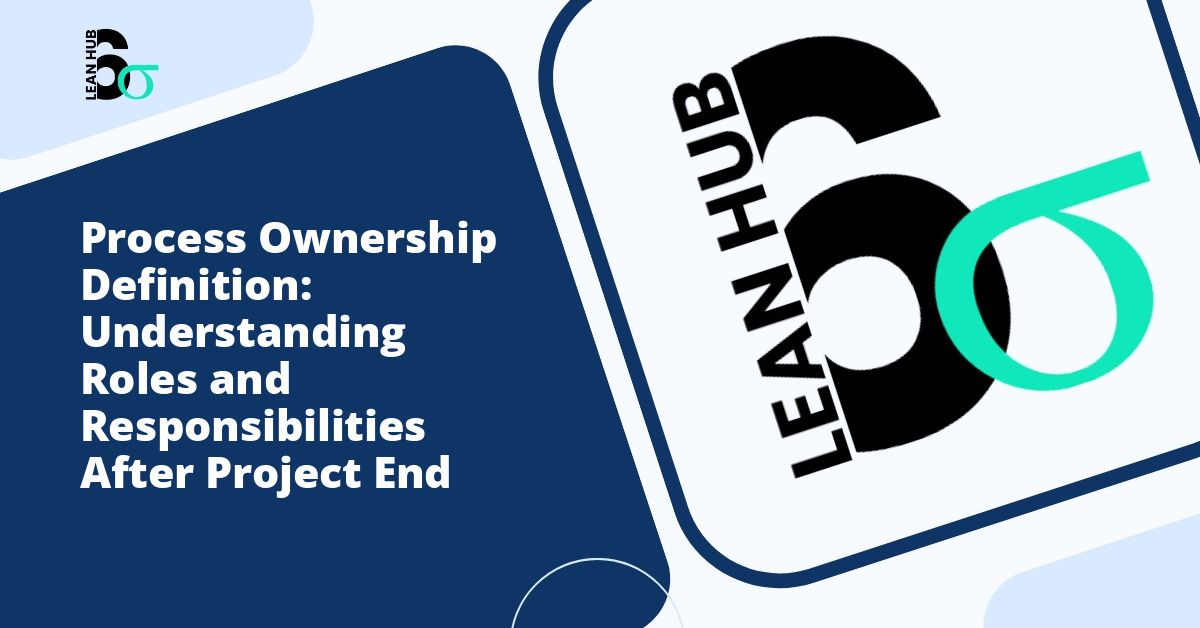In the world of business process improvement and operational excellence, the completion of a project marks not an ending, but rather the beginning of a new chapter. While teams often celebrate project completion as a major milestone, the critical phase that follows determines whether the improvements will sustain or gradually fade back to old ways of working. This is where process ownership becomes paramount, serving as the bridge between project completion and long-term operational success.
Understanding Process Ownership in the Modern Business Context
Process ownership refers to the assignment of accountability and responsibility for a specific business process to an individual or team within an organization. Unlike project management, which has a defined beginning and end, process ownership is an ongoing commitment that extends far beyond the project lifecycle. The process owner becomes the guardian of the improvements, ensuring that the benefits realized during the project phase continue to deliver value to the organization. You might also enjoy reading about Audit Plans for Six Sigma Projects: Ensuring Long-Term Process Compliance and Success.
In methodologies such as lean six sigma, the transition from project execution to operational sustainability represents a critical juncture. Many organizations invest significant resources in improvement initiatives, only to see gains erode over time due to unclear ownership and inadequate transition planning. Understanding and implementing robust process ownership structures can mean the difference between lasting transformation and temporary improvement. You might also enjoy reading about Process Owner Transition: How to Successfully Hand Off Your Improved Process.
The Critical Transition: From Project to Operations
When a process improvement project reaches completion, there exists a natural tendency for project team members to move on to their next assignments. However, the improved process requires continued attention, monitoring, and refinement. This transition period demands careful planning and clear communication about who will assume responsibility for various aspects of the process moving forward. You might also enjoy reading about Before and After Comparison: How to Document Improvement Results Effectively.
The recognize phase in process improvement frameworks specifically addresses this transition. During this phase, organizations formally acknowledge the completion of project activities while simultaneously establishing the foundation for sustained performance. This includes recognizing team achievements, documenting lessons learned, and most importantly, clearly defining who will own the process going forward.
Key Elements of Successful Process Ownership Transfer
A successful transition from project team to process owner involves several critical elements. First, comprehensive documentation must be prepared and transferred. This includes process maps, standard operating procedures, performance metrics, and troubleshooting guides. The documentation should be written in clear, accessible language that enables the process owner to understand not just what to do, but why certain decisions were made during the improvement project.
Second, knowledge transfer sessions should be conducted between the project team and the designated process owner. These sessions provide opportunities for questions, clarifications, and hands-on demonstrations of new procedures or systems. The goal is to ensure that the process owner feels confident and capable of managing the process independently.
Defining Process Owner Roles and Responsibilities
The process owner role encompasses a broad range of responsibilities that extend across multiple dimensions of process management. Understanding these responsibilities helps organizations select the right individuals for this critical role and ensures that process owners have the necessary authority and resources to succeed.
Primary Responsibilities of a Process Owner
Performance Monitoring and Reporting: Process owners must establish and maintain systems for tracking key performance indicators. This includes regular review of metrics, identification of trends, and reporting on process health to relevant stakeholders. The monitoring function serves as an early warning system, alerting the organization to potential issues before they become critical problems.
Continuous Improvement: While the initial improvement project may have delivered significant gains, the process owner remains responsible for identifying and implementing ongoing enhancements. This involves staying current with industry best practices, soliciting feedback from process participants, and fostering a culture of continuous improvement within their area of responsibility.
Compliance and Standards Maintenance: Process owners ensure that established standards and procedures are followed consistently. This includes conducting periodic audits, addressing deviations, and updating documentation as processes evolve. In regulated industries, this responsibility takes on added importance as process owners may be accountable for demonstrating compliance with regulatory requirements.
Resource Management: Effective process ownership requires appropriate allocation of resources, including personnel, technology, and budget. Process owners work with functional managers to ensure adequate staffing, training, and tools are available to support process execution.
Stakeholder Communication: Process owners serve as the primary point of contact for questions, concerns, and suggestions related to their process. They facilitate communication between different departments or functions that interact with the process and work to resolve conflicts or competing priorities.
Authority and Decision-Making Power
For process ownership to be effective, designated owners must possess sufficient authority to make decisions and drive changes within their scope of responsibility. Organizations sometimes make the mistake of assigning ownership without granting appropriate authority, which undermines the effectiveness of the role. Process owners should have the ability to modify procedures within defined parameters, allocate resources, and escalate issues when necessary.
Implementing Process Ownership in Lean Six Sigma Initiatives
Lean six sigma methodology provides a structured framework for process improvement that explicitly addresses the transition to operational ownership. Throughout the DMAIC cycle (Define, Measure, Analyze, Improve, Control), project teams work systematically to understand and enhance processes. However, the Control phase and the subsequent recognize phase specifically focus on sustainability and ownership transfer.
During the Control phase, project teams develop control plans that outline how the improved process will be maintained. These plans form the foundation of the process owner’s responsibilities. The control plan typically includes monitoring procedures, response protocols for out-of-control conditions, and schedules for periodic reviews.
The recognize phase then formalizes the transition. Organizations using lean six sigma approaches understand that recognition extends beyond celebrating success to acknowledging the new operational reality. This phase involves formal documentation of process ownership, communication of roles and responsibilities, and establishment of ongoing support structures.
Common Challenges in Process Ownership and How to Address Them
Despite best intentions, organizations frequently encounter obstacles when implementing process ownership structures. Recognizing these challenges and developing strategies to address them increases the likelihood of successful, sustained improvement.
Challenge: Lack of Clarity in Roles
When responsibilities are not clearly defined, confusion and gaps in accountability emerge. To address this challenge, organizations should create detailed role descriptions for process owners, distinguishing their responsibilities from those of functional managers, project managers, and individual contributors. Using a RACI matrix (Responsible, Accountable, Consulted, Informed) can help clarify who does what in relation to the process.
Challenge: Insufficient Time and Resources
Process ownership often becomes an additional responsibility layered onto already full workloads. Without dedicated time and resources, process owners struggle to fulfill their obligations effectively. Organizations should formally allocate time for process ownership activities and provide necessary tools and support systems.
Challenge: Resistance to Change
Even after a successful improvement project, some team members may resist new ways of working. Process owners need skills in change management and should receive training and support in addressing resistance, building buy-in, and fostering adoption of improved processes.
Best Practices for Sustainable Process Ownership
Organizations that excel at maintaining improvements over time typically follow several best practices in their approach to process ownership. These practices help ensure that the benefits achieved during project phases continue to deliver value long into the future.
- Select process owners based on both technical competence and leadership capability, recognizing that the role requires influence and communication skills in addition to process knowledge.
- Establish regular review cycles where process owners present performance data and discuss challenges with leadership, maintaining visibility and accountability.
- Create communities of practice where process owners can share experiences, learn from one another, and develop their capabilities over time.
- Build process ownership responsibilities into performance objectives and compensation structures, demonstrating organizational commitment to the role.
- Provide ongoing training and development opportunities specific to process ownership, including topics such as data analysis, problem-solving, and stakeholder management.
- Implement technology solutions that simplify monitoring and reporting, allowing process owners to focus on analysis and improvement rather than data collection.
Conclusion: Building a Culture of Process Ownership
The definition and implementation of clear process ownership structures represent critical success factors for organizations seeking to sustain improvements beyond project completion. While the excitement of project work often captures attention and resources, the quieter, ongoing work of process ownership ultimately determines whether improvements become embedded in organizational DNA or fade into memory.
By thoughtfully defining roles and responsibilities, providing appropriate authority and resources, and supporting process owners through training and recognition, organizations create the conditions for lasting operational excellence. The transition from project to operations, properly managed through frameworks like lean six sigma and formalized in the recognize phase, transforms temporary gains into permanent competitive advantages. Process ownership is not merely an administrative detail to be addressed at project end; it is the foundation upon which sustainable improvement is built.








